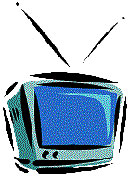Why does a room illuminated by a television appear blue?
[ 2006-04-19 08:52 ]
|
Color television pictures are produced by three different
colors: red,  green and blue. These combine to create a
whitish light with a color temperature close to that of
daylight (5500 to 6500 Kelvin). green and blue. These combine to create a
whitish light with a color temperature close to that of
daylight (5500 to 6500 Kelvin).
Color temperature is a way of describing the relative
amounts of the different colors that make up the light from a
particular source. It can be thought of roughly as the
temperature an object would need to be heated to give off
light with that mixture of wavelengths. At low temperatures,
low-energy colors such as red and yellow predominate; at
higher temperatures the proportions of green or blue increase.
For example, standard tungsten light bulbs have a
color temperature of 3200 K and are very yellow. Your eyes
adjust to this light, making it appear whiter and more like
daylight. At twilight or at night, anything with a
higher color temperature than tungsten lights, such as a
television, appears distinctly blue.
The same effect is seen if you look out of a room lit by
tungsten light. The twilight appears particularly blue, and
yet if you were to go outside and look at the same scene, the
eye would no longer compare it to the lit room and the colors
would appear more neutral.
The converse is also true. Viewed from outside, the
windows of houses lit by tungsten light sources look
distinctly yellow. Fluorescent sources generally have a
spectrum much closer to that of daylight and don't
produce the same effect. |
whitish:
發(fā)白的
Kelvin: 絕對(duì)溫標(biāo)
tungsten: 鎢
twilight: 黎明
converse: 相反的
fluorescent: 熒光的
spectrum: 光譜
| | |
|